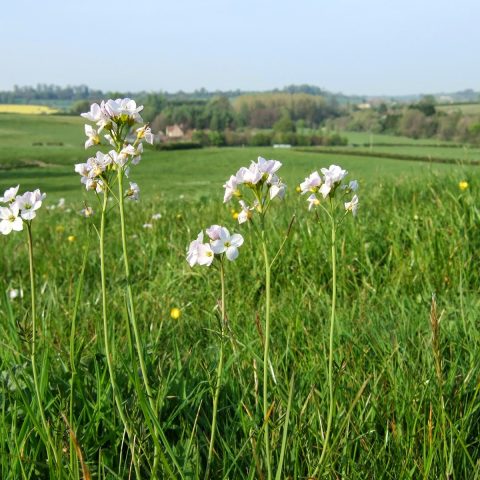Port of Milford Haven's story
Rising sea levels caused by climate change pose a major risk to coastal communities worldwide, including those in Pembrokeshire.
Tree planting is a popular and relatively simple way to help reduce flooding, isolate carbon and restore natural ecosystems. However, planting native trees in the right place is crucial to ensure our green spaces are genetically diverse and resilient against pests, diseases and climate change effects.
Aware of this and driven by the goals of the Well-being of Future Generations (Wales) Act, particularly to create a more resilient, prosperous and globally responsible Wales, in 2021 the Port of Milford Haven joined forces with the University College of Dublin to launch 'Coastal communities growing together' as part of the Coastal Communities Acting Together project.
The community tree planting project, which ran in spring 2021 part-funded by the European Union's Regional Development Fund through the Ireland-Wales Programme, invited schools and community groups along the Milford Haven Waterway to learn more about how native tree species can support biodiversity and mitigate climate change effects, as well as how and where to plant them.
They could then reserve a certain number of free trees each, to plant between 12th and 16th April 2021.
Nearly 2,000 trees (all native species) were planted by 838 people from 10 community groups and 12 schools along the Milford Haven Waterway.
In the lead-up to planting, we invited local community groups, schools and others to participate, sharing information about the project and key messages about trees' role in climate change fightback.
A website, created by project lead University College of Dublin using ESRI mapping and spatial analytics software shared guidance and support on species and planting, which was informed by experts at Pembrokeshire Coast National Park Authority and Tir Coed.
Applicants then filled in an online form that asked where they would plant, whether they felt the area would be affected by climate change, which trees they'd like to reserve and why they were participating.
The trees were delivered to participants ahead of the planting day, and experts from the Pembrokeshire Coast Council National Park Authority and Tir Coed were on hand to offer face-to-face support on planting day, where Covid-19 restrictions allowed.
A live and interactive mapping function on the website helped viewers visualise the project's impact – showing who planted what, where, and the potential impact on carbon sequestration over time. A carbon calculator translated what that carbon impact corresponded to in terms of day-to-day activities, such as the number of kettles boiled, flights between Cardiff and Cork airport, Instagram use or car journeys between Pembroke Dock and Milford Haven.
Useful learnings from Port of Milford Haven
When engaging local people in conversations about climate change effects on coastal communities, we knew it would be important to find shared ground. Tree planting became that shared ground.
It is an activity most people have some understanding of and support, but there was an opportunity to provide greater understanding of the care required to ensure a tree's survival and ongoing role in the climate fightback for future generations.
Tree planting is also popular with schools as outdoor learning offers a creative and effective way of achieving the Four Purposes of the new Welsh curriculum, and it was also in line with Welsh Government climate change targets. Welsh Government has since gone on to run a similar project, distributing a free tree to every household in Wales to tackle climate change and help towards a National Forest for Wales.
Covid-19 caused many last-minute revisions to our plans which was challenging. We had originally planned to provide trees to local households, but the pandemic and related restrictions on public gatherings prevented us organising the large collection days that would be needed.
Covid-19 also reduced opportunities for in-person engagement. Experts from our partner organisations, Tir Coed and Pembrokeshire Coast National Park Authority, were unable to attend planting days with community groups.
However, the pandemic did drive us to focus more on the technological and digital engagement strand of the project. The University College of Dublin poured its expertise and efforts into creating an interactive website that was intrinsic to information sharing. It also developed a carbon calculator, which was not originally within the scope of the project, to enable people to better understand and visualise the impact of their planting efforts. This innovative digital approach later won an impact case study prize from the university.
There were aspects of the pilot project that could benefit from tweaks. Coastal Communities growing Together is part of the Coastal Communities Adapting Together project, which has been developing and testing shared digital and non-digital tools and learning resources for citizens of all ages to observe their environment, interpret their findings, and co-create new ways of doing things. As it's a research project, there were administrative processes that required additional time and resource. Planning proved key.
There were also several asks of the participants, most unavoidable, which could benefit from being streamlined. They had to agree to absorb the information we shared, to meet the project's aim. They were also asked to film and photograph their planting activity and share it with us, as we couldn't attend planting days, and we requested they complete a post-planting feedback survey - perhaps too many steps when capacity was stretched.
Port of Milford Haven's metrics
Qualitative information gathered through surveys gave insight into people's knowledge on planting for climate change before and after their interaction with the project, as well as their motivation for participating.
The pre-planting survey, which was filled in to reserve the plants, provided quantitative data about the number of participants, the number and types of trees planted, and where.
A carbon calculator estimates the potential impact of the planting over the trees' estimated lifespan.






